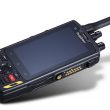How’s your antenna?
The difference in the light observed at the center of the parabolic beam and that of the bare bulb is gain
To the casual observer, it’s just a wire or just some sort of metallic nuisance that needs painting. We recognize it as an antenna, a metallic device, such as a rod or wire, for radiating or receiving radio waves. An antenna is most efficient when its physical length is appropriate for the frequency to be operated. The physical length is determined by its relation to wavelength (λ), which in turn is related to the speed of light.
The velocity of light, V, is roughly 186,000mi./s. Multiplying V by 5,280ft./mi. yields 984 × 108ft./s. Megahertz is a million events per second. One wavelength is also one hertz, which is also equal to one period of events per second. Therefore, 984,000,000 divided by frequency equals one wavelength (1λ).
One wavelength = 984 ÷ F(MHz). For the ½ dimension, in feet, 492 is the value to be divided by the frequency, and 492 ÷ F(MHz) = ½, in feet.
Example: 984 ÷ 155MHz = 6.35ft. = 1λ.
½ = 3.175ft.
3.175ft. × 12 in./ft. = 38.1in.
¼ = 19.05in.
All of the above is relative to the speed of light. If we are going to use wires or conductors of any type as the antenna, then things take on a different characteristic. Anything other than free space will slow down energy, and the ratio of free-space travel to conductor travel is the velocity factor, usually noted as vp.
The isotropic antenna is a fictitious antenna, also called the point source. It is analogous to a bare flashlight bulb theoretically illuminating a room evenly. When the flashlight bulb is placed at the focal point of a parabolic reflector, a light beam is formed. The difference in the light observed at the center of the parabolic beam and that of the bare bulb is gain. This comparison relates directly to microwave antennas that use a parabolic dish. In fact, microwave antennas are compared to the isotropic antenna, and all gains are written as units of dBi, meaning decibels relative to a hypothetical isotropic antenna.
By definition, the dipole antenna is a ½ conductor, with energy supplied in the center, as shown in Figure 1 on page 49. It is a balanced-feed device, and its parameters are measured or compared at a height above ground of ¼. Its gain, compared to the isotropic antenna, is 2.15dBi. This antenna is easily built and calibrated, and it is the standard antenna for measurements of frequencies below 900MHz. Antennas with non-dBi gain figures are given in units of dBd (i.e., referenced to the dipole). Figure 2 on page 49 shows the voltage and current relationship of a ½ dipole antenna.
Let’s look at an antenna for its feed point impedance over several wavelengths. Keeping the physical length constant, the frequency will be changed and the base impedance measurements can be taken and the results plotted as shown in Figure 3 on page 49. A horizontal line that represents 0Ω resistance at the left and approaches infinity at the right represents the resistance. Inductive reactance lies above the horizontal line, and capacitive reactance lies below.
In the electronics world, we like to have everything resistive. So, looking at the spiral, we determine that if we operate at the point where the spiral line crosses the resistive line, the antenna would then be resonant. (The energy boys call this point unity power factor.)
So, is the free-space formula in error? Not really, it just needs some modification. In reality, the frequency that provided this zero reactive point was plugged into the formula to find a “K” factor that would modify the free-space formula, 492 ÷ F(MHz), to bring us to the zero point. That “K” factor is 0.95 for wire antennas up to about 30MHz. Beyond 30MHz, the diameter of the wire also affects the overall length for a pure resistive impedance. The result is the classic 468 ÷ F(MHz) seen in most text books for a ½ antenna.
Figure 4 on page 50 shows the impedance spiral of a ½ antenna cut to the dimensions of 468 ÷ F(MHz). Again, this is only good for wire antennas or thin elements for the lower frequencies and at ¼ above ground. The lower the antenna is to ground, the lower this impedance will become. A rule of thumb is if the antenna is about above ground, the impedance will measure somewhere around 50Ω. In the amateur radio band, this means an 80m antenna up 30′ will closely match the magic number of 50Ω. Also note that the antenna has a higher impedance in the center if it is 1λ long. At ¾, the center impedance is again low. That means a center-fed antenna can and will operate on the 3rd harmonic. Examples would be a ½ on 7MHz and a ¾ on 21MHz.
Figure 5 on page 50 shows the impedance spiral of a ¼ antenna cut for free-space dimensions. Note that the numbers are exactly one-half of the ½ dipole: Zo = 36 × j21Ω. Again, the element must be shortened to yield pure resistance, using the same formula except ½ of the total length. The only difference between this antenna and the dipole is that the ground plane is considered infinite in length. In reality, it need only be ½ diameter in all directions. The ¼ antenna is a low-impedance, or current-fed, antenna, as shown in Figure 6 above. It has a voltage minimum at the feed point and again at the ¾ point. Advantages of a ¾ antenna are that the impedance can be near 60Ω (a better match than the ¼), and a minor lobe appears above the horizon, which is helpful with radiation to higher sites.
Figure 7 shown above amplifies another consideration of the radiating element. Large diameters lower the antenna’s quality factor, or “Q.” In other words, it makes it a broadband device. There is a larger spread of frequencies with which the antenna will operate with acceptable standing wave ratio. This is primarily due to the amount of capacity added because of the increased area. To keep the antenna resonant, the conducting element must be shortened to compensate for the added capacity. This brings the topic of the ratio of diameter of radiating element to wavelength dimensions, as shown in Figure 8 on page 51. In other words, the “K” factor is the determinate when the antenna element is larger than a small wire. In the case of VHF, anything larger than a rod must use a K factor less than 0.95.
The AM broadcast industry first identified antenna characteristics in the 1920s. Vertical antennas were used because the radiation is uniform from the center of the tower. Dipole antennas have directivity, with nulls at the ends of the conductor. The broadcasters’ interest was to obtain the most signal strength, so the vertical antenna underwent a series of tests to determine the optimum height. Figure 9 on page 51 graphs signal strength measured with different vertical antenna heights and 1kW of power. Note that maximum power is received with the antenna at 0.625λ, and almost nothing at one wavelength.
Figure 10 above graphs a side view of radiation with different antenna heights. At the 5/8λ, you can see there is a minor lobe beginning at the 75° point, that gets somewhat larger at ¾ (not shown). Installing a ¾ antenna is an attractive prospect for vehicles because this antenna not only radiates in the horizontal but also has an elevated signal that can bounce off buildings. The ¾ is particularly effective for motorcycle radios using the VHF band. The impedance of a ¾ vertical is closer to 50Ω than the ¼ antenna.
The late James L. Larsen, founder of Larsen Antennas, introduced the antenna for mobile use by incorporating a coil at the feed point that cancels the capacitive reactance, leaving the antenna just above 50Ω resistive. It is marketed as the 3dB gain VHF antenna.
Another example of antenna impedance vs. height is shown in Figure 11 above. Any multiple of ½ results in high impedance, sometimes referred to as voltage feed. Multiples of ¼ are referred to as current feed.
It should be pointed out that even a small piece of wire is a high-impedance device, if it is measured with an ohmmeter. It is only low resistance when it’s employed as a resonant device.
Buller is a special projects engineer for Tacoma Power, Tacoma, WA. For many years he served as an electronics design engineer for the Washington State Patrol. He is a member of IEEE, NARTE, APCO and ARRL, and he is a Fellow of the Radio Club of America. His email address is [email protected].












